#white hooded merganser
Explore tagged Tumblr posts
Text

White hooded merganser at Otterbein Lake
55 notes
·
View notes
Text
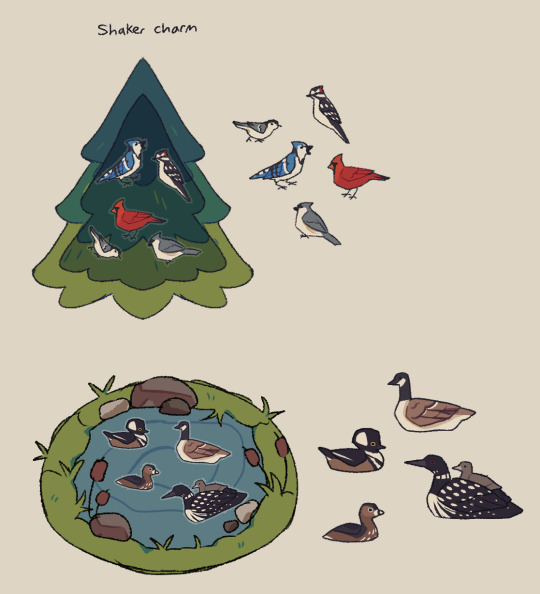
I've been thinking about making tree and pond/lake bird shaker charms... What do you guys think? :^0 I'm not sure if people would be super interested
#my art#digital art#art#artists on tumblr#illustration#bird#birds#birding#bird art#merch#charms#white breasted nuthatch#downy woodpecker#blue jay#northern cardinal#tufted titmouse#canada goose#hooded merganser#common loon#pied billed grebe
175 notes
·
View notes
Text



Hooded Merganser 🖤🦆🤍
Please credit if you use my gifs!
#black#white#nature#birds#wild birds#waterfowl#water birds#duck#merganser#hooded merganser#lake#water#animal#stim#stimmy#stimming#stimblr#sensory#gifset#stim gifs#gifs#fizzy gifs#animal stim
10 notes
·
View notes
Video
IMG_0025 by Henry Via Flickr: Hooded merganser
3 notes
·
View notes
Text
huge respect to @myxinidaes for reblogging that post with 100 birds
#ok im gonna try to list 100 birds. house sparrow song sparrow fox sparrow white-throated sparrow dark-eyed junco#robin. ovenbird. hermit thrush. carolina wren. cardinal#carolina chickadee. house finch. purple finch. goldfinch. white-breasted nuthatch#red-breasted nuthatch. hooded merganser. american coot. wood duck. mallard duck#surf scoter. ruddy duck. black duck. northern shoveler. common loon#crow. fish crow. raven. turkey vulture. bald eagle#feral pigeon. mourning dove. turkey. quail. AMERICAN WOODCOCK#solitary sandpiper. herring gull. great black-backed gull. piping plover. killdeer#yellow-rumped warbler. pine warbler. palm warbler. black and white warbler. i cant think of a fifth warbler. red tailed hawk#cooper's hawk. osprey. barn swallow. tree swallow. blue jay#peacock. egyptian goose. peregrine falcon. merlin. canadian goose#green heron. starting to struggle here. flamingo. skua. albatross. great blue heron#barn owl - snowy owl - great horned owl - barred owl - WHAT was that little owl in central park called - uhhh mandarin duck#chicken. california condor. rose finch (there are many but i dont remember any of the weirder species). adelie penguin. emperor penguin#northern mockingbird.. starling.. grackle.. african gray parrot.. monk parakeet#stellar's jay ... baltimore oriole.. argh what's the other oriole we get. DOWNY WOODPECKER.. hairy woodpecker... pileated woodpecker#red-headed woodpecker. red-bellied woodpecker. ruby-throated hummingbird. scarlet macaw. whooping crane#whippoorwill. snowy egret. great egret. european robin. bird of paradise#there's a warbler that's just 'yellow' right? yellow warbler? cormorant...#struggling with some where i cant remember the exact name like was it a 'double crested' cormorant or something else.#zebra finch .. blue-footed booby... pelican....#australian magpie. The Other Magpie. ibis (nonspecific). potoo. EASTERN BLUEBIRDDDDDD !!!#ceruleanrambling#now i can go read yours
20 notes
·
View notes
Text
How do all of these fuck so hard
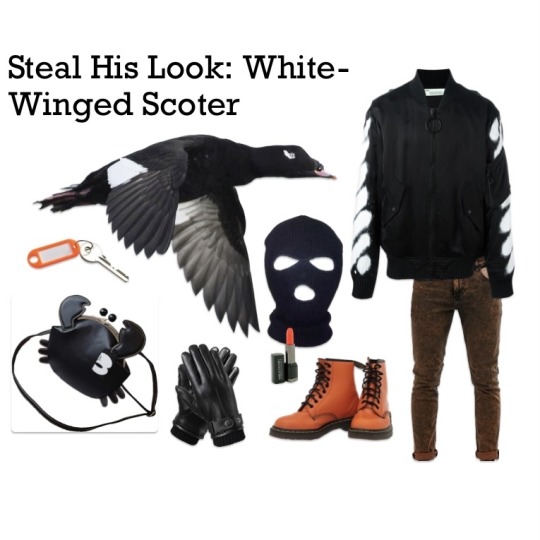
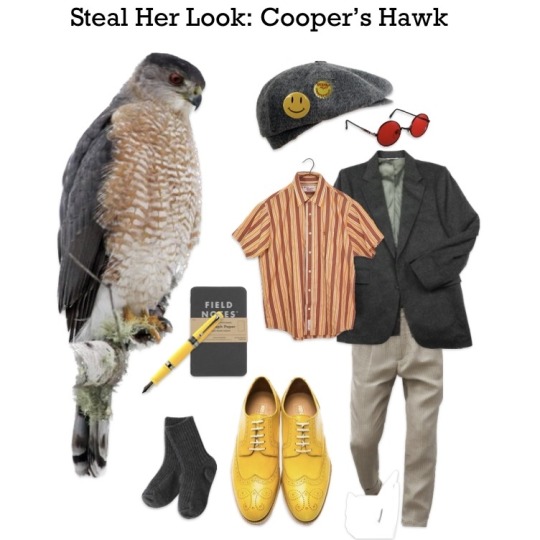
These are so fun to make
#beautiful things#fashion#art inspiration#oc inspiration#birds#white winged scoter#cooper's hawk#hawks#carolina wren#wrens#common loon#cassowary#ruby throated hummingbird#hummingbirds#red tailed black cockatoo#cockatoos#ocellated turkey#turkeys#lyrebird#shoebill#shoebill stork#storks#hooded crow#crows#scaly sided merganser#barn owl#harpy eagle#eagles#blue jay#jays
125K notes
·
View notes
Text
Bird Pictures January '24
Pine Warbler Golden-crowned Kinglet Great Blue Heron Tufted Titmouse Ruby-crowned kinglet Yellow-rumped Warbler Hooded Mergansers Pair of Hooded Mergansers Goldfinch Hermit Thrush Blue-headed Vireo Double-crested Cormorant White-breasted Nuthatch Brown Creeper Yellow-bellied Sapsucker Red-bellied Woodpecker (male) Downy Woodpecker (male) The earth is the LORD’s and the fullness…

View On WordPress
#blue-headed vireo#brown creeper#double-crested cormorant#downy woodpecker#golden-crowned kinglet#goldfinch#Great Blue Heron#hermit thrush#hooded mergansers#pine warbler#Red-bellied woodpecker#ruby-crowned kinglet#Tufted Titmouse#white-breasted nuthatch#yellow-bellied sapsucker#yellow-rumped warbler
0 notes
Text
Every day that I get to see a white-hooded merganser is a good day! And I get to see white-hooded mergansers every day at work, so every day is a good day!
37 notes
·
View notes
Text











I HOPE YOU LIKE BIRDIES. I went out on a productive photo walk.
From top to bottom, left to right: - female hooded merganser - winter-phase American goldfinch - white-crowned sparrow - female and male American wigeon - immature white-crowned sparrow Munchin' - leucistic?? mallard. she's got somethin' going on - male American kestrel - great blue heron - common merganser following the rules - male American wigeon - male hooded merganser
#shoutout to the ring-neck ducks I just didn't get good photos of you#my photos#birds#wildlife photography#birding#oregon
16 notes
·
View notes
Text
Last weekend I was planning to drive out to the west side to pick up a load of birdseed. My coworker had told me that he was out at Tiedeman's Pond the other day, and I said to myself, "I bet there's ducks on that pond. I better go check." So I grabbed my camera bag on the way out the door. And folks? There were ducks.
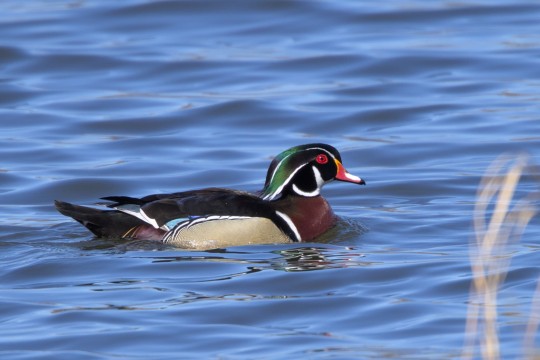
[ID: A male Wood Duck swims on a pond of rippling blue water from left to right. The duck is presenting his entire profile to the camera, from glossy green head to dark tail tip. He has a brown body, more burgundy at the breast, with finely scaled tan and gray flanks and just a hint of teal peeking through on the wing. Each color patch is bordered with a brilliant white stripe, including a lovely pattern on the face and head. His head feathers are swept back in a longish crest that looks black except for the iridescent green where the sun has caught it. This contrasts with a striking bill in orange gradients with a white patch on top and black tip. His eye is a bold fire engine red. End ID]
I was surprised to find multiple pairs of Wood Ducks very close to the edge of the pond, because these guys will usually fly at the first sign of a human in the area. I can only assume they were desensitized by the frequent groups of walkers out with their kids and their dogs.
There were lots of other ducks to be seen: Lesser Scaups, Hooded Mergansers, Buffleheads, Ruddy Ducks, Mallards. But most of these were way out at the center of the pond and not interested in being photographed. The only exception being a small group of Ring-necked Ducks that were diving for food near the cattails.
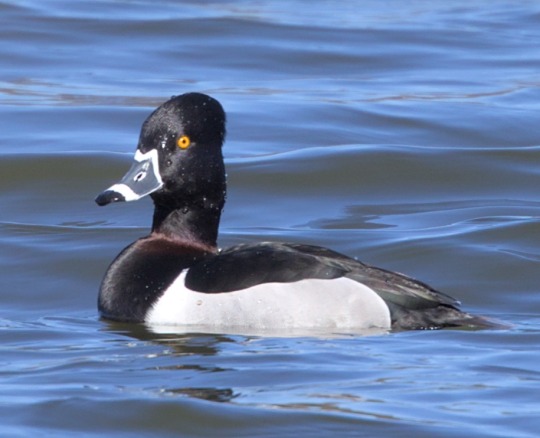
[ID: A male Ring-necked Duck swims from right to left on the pond. It is glossy black, with light gray flanks fading to white towards the front. His bill is medium gray in the middle, black on the tip, with a bright white border around the edges, circling the nostrils, and separating gray from black. His eye is yellow orange. His feathers are beaded with water droplets from diving for food. End ID]
But it wasn't just ducks on offer that day! Spring means birds migrating back from the south and hungry from the long flight. I got to watch a pair of Great Blue Herons show up and immediately begin hunting.
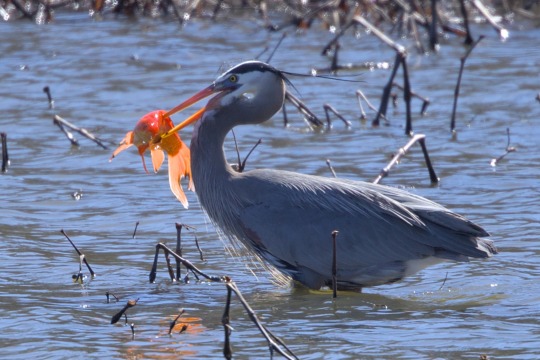
[ID: A Great Blue Heron is standing in a pond, with a freshly-caught goldfish in its bill. The Heron is standing with its legs completely submerged in the water, with its long neck coiled back as it pulls up the large goldfish. The Heron is several feet tall, mostly gray, with white on their head and a dark blue cap with long trailing feathers at the back. The goldfish is at least eight inches long, and the Heron appears to have speared it on their long upper mandible, which glows orange from the bright sunlight filtering through from behind. End ID]
I was very happy to see that the Herons were doing their part to control the non-native fish population. This one had speared a very large goldfish, and had to think a minute about how to eat it. They dropped the goldfish back in the water only to recapture it for swallowing head-first. Their partner looked on from a short distance away, not having found anything while I was there.
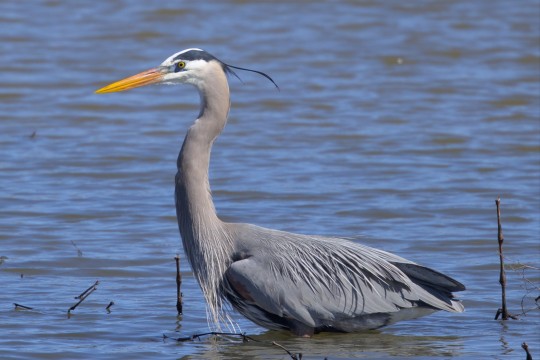
[ID: A second Great Blue Heron slowly wades by, hunting in the shallow part of the pond. This one shows a flash of dark-blue tail feathers, and the direct sunlight offers a nice view of their bright yellow dagger of a bill and their pale yellow eye rimmed in baby blue skin. End ID]
And it wasn't just water birds that were attracted to the awakening pond. This American Crow flew down to the edge to see what small morsels might be crawling around in the mud.

[ID: An American Crow stands at the edge of the pond. The Crow is facing away from the camera, with the sunlight glinting off their glossy black feathers. They are looking toward the camera in profile, showing one brown eye and a chunky black bill. End ID]
The Black-capped Chickadees were out too. This pair had found a nice little tree cavity, and they may have been excavating it further to use as a nest.

[ID: A Black-capped Chickadee peeks out from a tree hollow, holding a small bit of something in their bill. They are just a couple inches tall, with a gray and tan body, and a predominantly black head. They have white cheeks that start at the small black bill and extend back to the neck. They are staring inquisitively at the camera, with little bits of what looks like wood stuck to their face. End ID]
The two Chickadees seemed to be working in shifts, one keeping watch outside while the other one went in to prep the house. I wonder how many generations of birds have grown up in that little knothole...
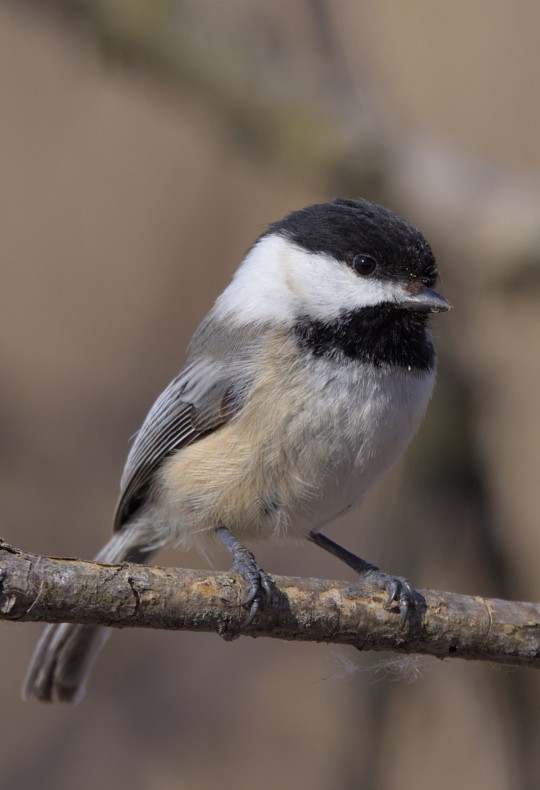
[ID: A second Black-capped Chickadee perches on a thin branch with delicate feet. They are sitting very still, keeping watch while their partner works in a nearby tree cavity. There are a few tiny flecks of what might be wood on their face. End ID]
Though, the bird that gave me the most excitement on this walk was a new one. My partner teases me, saying that I have to check every seagull to see whether they're a Herring or a Ring-billed. But on this day I had found a Bonaparte's Gull!
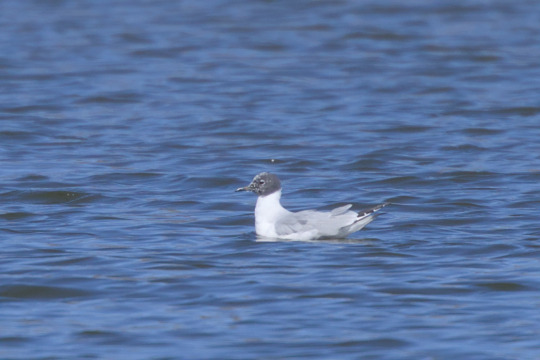
[ID: A Bonaparte's Gull floats out in the middle of the pond. The Gull is white with light gray wings and black wingtips. Their head is mostly gray with patches of white, possibly because they're in the middle of molting to grow their breeding plumage. End ID]
The Gull was hanging out with a nice flock of Lesser Scaups, and I knew I had a lifer in my binoculars as soon as I saw that gray head. Every so often it would take off and fly around the pond, looking for tasty fish to snatch from the surface. They never wandered all that close to me, but I got a few nice shots of those wings.
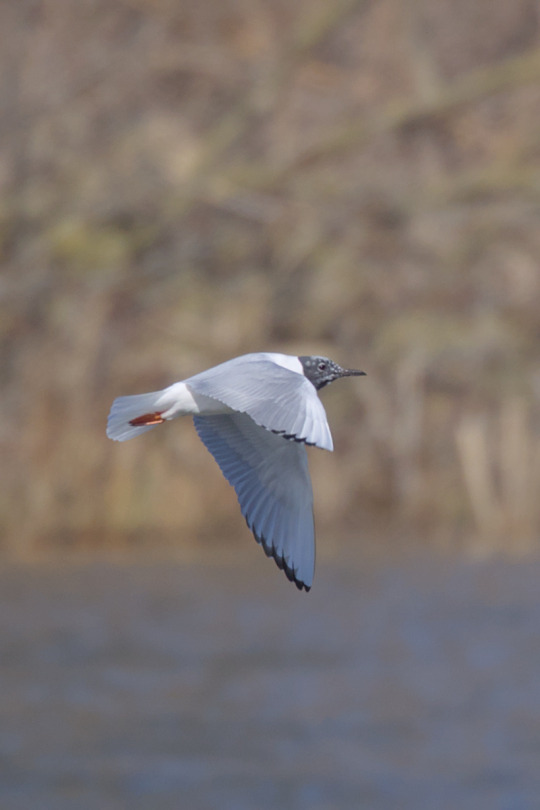
[ID: The Bonaparte's Gull flies low over the pond, on the hunt for small fish. With wings fully extended, it is apparent that the black wingtips are just a thin crescent at the tip of each primary flight feathers. The Gull is in the middle of a down stroke, head forward, orange feet tucked neatly beneath fanned gray tail. End ID]
For only visiting on a whim, this was a very productive walk. I saw 35 bird species, seven for the first time this year, and one for the first time ever. I suppose that's why birders wait all year for spring migration to start.
#bird#bird photography#birding#photography#birds#birdblr#birdlife#birdwatching#original photography#original photography on tumblr#duck#heron#gull#wood duck#ring-necked duck#great blue heron#american crow#black capped chickadee#bonaparte's gull#lifer
29 notes
·
View notes
Note
i have a list of bird suggestions if you're still taking them!
- white-breasted nuthatch
- burrowing owl
- red-breasted nuthatch
- purple finch
- hooded merganser
- pileated woodpecker
- merlin
- common yellowthroat
- american redstart
- eastern wood-peewee
- ovenbird
- black-billed cuckoo
- cedar waxwing
- chimney swift
White breasted nuthatch, red breasted nuthatch, eastern wood pewee, and chimney swift have been posted already, and the rest have been queued!
#sorry I'm behind on queuing requests! I'll get to them all eventually#not a botd#asks#request#strawberrygiorno
14 notes
·
View notes
Text
What's the Bird?
Location: Seattle, WA
Date: March

We ask that discussion under questions be limited to how you came to your conclusion, not what your conclusion was.
Happy Birding!
Keep the game alive! Submit a bird HERE
19 notes
·
View notes
Text
Hooded Mergansers (Lophodytes cucullatus)

Here are a couple of hooded mergansers that I saw on a hidden pond in Albany, Georgia last November. There were 50-100 of them at the far end of the pond.
"“Hooded” is something of an understatement for this extravagantly crested little duck. Adult males are a sight to behold, with sharp black-and-white patterns set off by chestnut flanks. Females get their own distinctive elegance from their cinnamon crest. Hooded Mergansers are fairly common on small ponds and rivers, where they dive for fish, crayfish, and other food, seizing it in their thin, serrated bills. They nest in tree cavities; the ducklings depart with a bold leap to the forest floor when only one day old." - allaboutbirds.org
#photo#photography#photographer#photographylovers#birds#birdsofmastodon#birdwatching#birds of north america#birdsphotography#birdlovers#birdphotography#birdingphotography#birds nature#hooded merganser#bird#bird watching#bird photography#birding
42 notes
·
View notes
Video
IMG_0039 by Henry Via Flickr: American wigeon
3 notes
·
View notes
Text
List of Birds organized by Order + locations:
Accipitriformes:
Bearded vulture
California condor
Cooper's hawk
Osprey
Red-shouldered hawk
Steller's sea eagle
Anseriformes:
Bar-headed goose
Barnacle goose
Black swan
Common merganser
Red-breasted goose
Snow goose
Trumpeter swan
Apodiformes:
Common swift
Ruby-throated hummingbird
Bucerotiformes:
Eurasian hoopoe
Cariamiformes:
Red-legged seriema
Casuariiformes:
Emu
Southern cassowary
Cathartiformes:
Black vulture
Turkey vulture
Charadriiformes:
American oystercatcher
Atlantic puffin
Black-headed gull
Black skimmer
Black-tailed godwit
European herring gull
Killdeer
Northern lapwing
Ruddy turnstone
Western sandpiper
Ciconiiformes:
White stork
Columbiformes:
Common wood pigeon
Eurasian collared dove
Luzon bleeding-heart
Nicobar pigeon
Victoria crowned pigeon
Coraciiformes:
Blue-capped kingfisher
Common kingfisher
Cuculiformes:
Asian koel
Greater roadrunner
Yellow-billed cuckoo
Eurypygiformes:
Kagu
Falconiformes:
American kestrel
Common kestrel
Galliformes:
Palawan peacock-pheasant
Plain chachalaca
Scaled quail
Western capercaillie
Gaviiformes:
Common loon
Gruiformes:
American coot
Australasian swamphen/pūkeko
Blue crane
Common moorhen
Sandhill crane
Sora
Whooping crane
Passeriformes:
American bushtit
American robin
Australian raven
Baltimore oriole
Barn swallow
Black-billed magpie
Black-capped chickadee
Black-headed grosbeak
Black-throated sparrow
Blue-headed vireo
Blue jay
Bluethroat
Brown thrasher
California scrub jay
California towhee
Canada warbler
Canyon wren
Cave swallow
Cedar waxwing
Common blackbird
Common chlorospingus
Common raven
Eastern wood pewee
Eurasian blue tit
Eurasian bullfinch
Eurasian golden oriole
Eurasian jay
Eurasian magpie
European robin
Goldcrest
Great-tailed grackle
Great tit
Hooded crow
House sparrow
Indigo bunting
Kirtland's warbler
LeConte's sparrow
Long-tailed tit
Mexican jay
Painted bunting
Phainopepla
Pine siskin
Pin-tailed whydah
Pinyon jay
Pygmy nuthatch
Red winged blackbird
Rook
Saltmarsh sparrow
Satin bowerbird
Spotted towhee
Steller's jay
Tufted titmouse
Wallcreeper
Warbling vireo
Western tanager
White-breasted nuthatch
White-throated dipper
White-throated magpie-jay
Yellow-rumped warbler
Pelecaniformes:
Black-crowned night heron
Brown pelican
Great blue heron
Great egret
Great white pelican
Least bittern
Roseate spoonbill
Shoebill stork
Snowy egret
Phoenicopteriformes:
American flamingo
Chilean flamingo
Piciformes:
Acorn woodpecker
Clark's nutcracker
Great spotted woodpecker
Lesser spotted woodpecker
Lewis's woodpecker
Northern flicker
Pileated woodpecker
Red-bellied woodpecker
Red-headed woodpecker
Podargiformes:
Tawny frogmouth
Podicipediformes:
Pied-billed grebe
Procellariiformes:
Wilson's storm-petrel
Psittaciformes:
Australian king parrot
Chestnut-fronted macaw
Citron-crested cockatoo
Cockatiel
Galah
Gang-gang cockatoo
Pacific parrotlet
Red-masked parakeet
Rose-ringed parakeet
Sulphur-crested cockatoo
Strigiformes:
Barn owl
Barred owl
Eurasian eagle-owl
Suliformes:
Anhinga
Blue-footed booby
Double-crested cormorant
Trogoniformes:
Elegant trogon
Locations:
Africa
America
Antarctica
Asia
Australia
Eurasia
Europe
Oceania
8 notes
·
View notes
Text
All animal species (and a couple algae) that have kept the same scientific name since Linnaeus
The first work of taxonomy that is considered as having any scientific authority for animal species was the 10th edition of Linnaeus' Systema Naturae, published in 1758. (Also a book on spiders called Aranei Suecici, published one year before.) That's the foundational text of the binominal system of nomenclature of species still in use today. Since then most of Linnaeus' original species (4379 species, of which 185 mammals, 554 birds, 217 "amphibians" (including reptiles and cartilaginous fish), 379 fishes, 2104 "insects" (including various arthropods, of which 664 are beetles and 543 are moths & butterflies crammed into only 3 genera), and 940 "worms" (including basically all other invertebrates, and even some protists and algae)) have been dismembered, renamed, or at least moved to different genera (e.g. the house sparrow went from Fringilla domestica to Passer domesticus).
Here is a list of all of Linnaeus' original species from 1758 that still retain their original name. I believe they are 484 in total.
"Mammalia"
(Primates)
Homo sapiens (human)
Lemur catta (ring-tailed lemur)
Vespertilio murinus (rearmouse bat)
(Bruta)
Elephas maximus (Asian elephant)
Trichechus manatus (West Indian manatee)
Bradypus tridactylus (three-toed sloth)
Myrmecophaga tridactyla (giant anteater)
Manis pentadactylus (Chinese pangolin)
(Ferae)
Phoca vitulina (harbor seal)
Canis familiaris (dog)
Canis lupus (grey wolf)
Felis catus (house cat)
Viverra zibetha (Indian civet)
Mustela erminea (stoat)
Mustela furo (ferret)
Mustela lutreola (European mink)
Mustela putorius (wild ferret)
Ursus arctos (brown bear)
(Bestiae)
Sus scrofa (wild boar/pig)
Dasypus septemcinctus (seven-banded armadillo)
Dasypus novemcinctus (nine-banded armadillo)
Erinaceus europaeus (European hedgehog)
Talpa europaea (European mole)
Sorex araneus (common shrew)
Didelphis marsupialis (common opossum)
(Glires)
Rhinoceros unicornis (Indian rhinoceros)
Hystrix brachyura (Malayan porcupine)
Hystrix cristata (crested porcupine)
Lepus timidus (common hare)
Castor fiber (European beaver)
Mus musculus (house mouse)
Sciurus vulgaris (red squirrel)
(Pecora)
Camelus dromedarius (dromedary camel)
Camelus bactrianus (Asian camel)
Moschus moschiferus (musk deer)
Cervus elaphus (red deer)
Capra hircus (goat)
Capra ibex (Alpine ibex)
Ovis aries (sheep)
Bos taurus (cow)
Bos indicus (zebu)
(Belluae)
Equus caballus (horse)
Equus asinus (donkey)
Equus zebra (mountain zebra)
Hippopotamus amphibius (hippopotamus)
(Cete)
Monodon monoceros (narwhal)
Balaena mysticetus (bowhead whale)
Physeter macrocephalus (sperm whale)
Delphinus delphis (common dolphin)
"Aves"
(Accipitres)
Vultur gryphus (Andean condor)
Falco tinnunculus (common kenstrel)
Falco sparverius (sparrowhawk)
Falco columbarius (pigeonhawk)
Falco subbuteo (Eurasian hobby)
Falco rusticolus (gyrfalcon)
Strix aluco (tawny owl)
Lanius excubitor (great grey shrike)
Lanius collurio (red-backed shrike)
Lanius schach (long-tailed shrike)
(Picae)
Psittacus erithacus (grey parrot)
Ramphastos tucanus (white-throated toucan)
Buceros bicornis (great hornbill)
Buceros rhinoceros (rhinoceros hornbill)
Crotophaga ani (smooth-billed ani)
Corvus corax (raven)
Corvus corone (carrion crow)
Corvus frugilegus (rook)
Corvus cornix (hooded crow)
Coracias oriolus (golden oriole)
Coracias garrulus (European roller)
Gracula religiosa (hill myna)
Paradisaea apoda (greater bird-of-paradise)
Cuculus canorus (common cuckoo)
Jynx torquilla (wryneck)
Picus viridis (green woodpecker)
Sitta europaea (Eurasian nuthatch)
Merops apiaster (European bee-eater)
Merops viridis (blue-throated bee-eater)
Upupa epops (Eurasian hoopoe)
Certhia familiaris (Eurasian treecreeper)
Trochilus polytmus (red-billed streamertail hummingbird)
(Anseres)
Anas platyrhynchos (mallard duck)
Anas crecca (teal duck)
Mergus merganser (common merganser)
Mergus serrator (red-breasted merganser)
Alca torda (razorbill auk)
Procellaria aequinoctialis (white-chinned petrel)
Diomedea exulans (wandering albatross)
Pelecanus onocrotalus (great white pelican)
Phaeton aethereus (red-billed tropicbird)
Larus canus (common gull)
Larus marinus (great black-backed gull)
Larus fuscus (lesser black-backed gull)
Sterna hirundo (common tern)
Rhynchops niger (black skimmer)
(Grallae)
Phoenicopterus ruber (American flamingo)
Platalea leucorodia (Eurasian spoonbill)
Platalea ajaia (roseate spoonbill)
Mycteria americana (wood stork)
Ardea cinerea (grey heron)
Ardea herodias (blue heron)
Ardea alba (great egret)
Scolopax rusticola (Eurasian woodcock)
Charadrius hiaticula (ringed plover)
Charadrius alexandrinus (Kentish plover)
Charadrius vociferus (killdeer plover)
Charadrius morinellus (Eurasian dotterel)
Recurvirostra avosetta (pied avocet)
Haematopus ostralegus (Eurasian oystercatcher)
Fulica atra (Eurasian coot)
Rallus aquaticus (water rail)
Psophia crepitans (grey-winged trumpeter)
Otis tarda (great bustard)
Struthio camelus (ostrich)
(Gallinae)
Pavo cristatus (Indian peafowl)
Meleagris gallopavo (wild turkey)
Crax rubra (great curassow)
Phasianus colchicus (common pheasant)
Tetrao urogallus (western capercaillie)
(Passeres)
Columba oenas (stock dove)
Columba palumbus (wood pigeon)
Alauda arvensis (Eurasian skylark)
Sturnus vulgaris (European starling)
Turdus viscivorus (mistle thrush)
Turdus pilaris (fieldfare thrush)
Turdus iliacus (redwing thrush)
Turdus plumbeus (red-legged thrush)
Turdus torquatus (ring ouzel)
Turdus merula (blackbird)
Loxia curvirostra (crossbill)
Emberiza hortulana (ortolan bunting)
Emberiza citrinella (yellowhammer)
Emberiza calandra (corn bunting)
Fringilla coelebs (common chaffinch)
Motacilla alba (white wagtail)
Motacilla lava (yellow wagtail)
Parus major (great tit)
Hirundo rustica (barn swallow)
Caprimulgus europaeus (European nightjar)
"Amphibia"
(Reptiles)
Testudo graeca (Greek tortoise)
Draco volans (flying dragon)
Lacerta agilis (sand lizard)
Rana temporaria (common frog)
(Serpentes)
Crotalus horridus (timber rattlesnake)
Crotalus durissus (tropical rattlesnake)
Boa constrictor (common boa)
Coluber constrictor (eastern racer)
Anguis fragilis (slowworm)
Amphisbaena alba (red worm lizard)
Caecilia tentaculata (white-bellied caecilian)
(Nantes)
Petromyzon marinus (sea lamprey)
Raja clavata (thornback ray)
Raja miraletus (brown ray)
Squalus acanthias (spiny dogfish)
Chimaera monstrosa (rabbitfish)
Lophius piscatorius (anglerfish)
Acipenser sturio (sea sturgeon)
Acipenser ruthenus (sterlet sturgeon)
"Pisces"
(Apodes)
Muraena helena (Mediterranean moray)
Gymnotus carapo (banded knifefish)
Trichiurus lepturus (cutlassfish)
Anarhichas lupus (Atlantic wolffish)
Ammodytes tobianus (lesser sandeel)
Xiphias gladius (swordfish)
Stromateus fiatola (blue butterfish)
(Jugulares)
Callionymus lyra (common dragonet)
Uranoscopus scaber (stargazer)
Trachinus draco (greater weever)
Gadus morhua (Atlantic cod)
Blennius ocellaris (butterfly blenny)
Ophidion barbatum (snake cusk-eel)
(Thoracici)
Cyclopterus lumpus (lumpsucker)
Echeneis naucrates (sharksucker)
Coryphaena equiselis (pompano)
Coryphaena hippurus (dorado)
Gobius niger (black goby)
Govius paganellus (rock goby)
Cottus gobio (European bullhead)
Scorpaena porcus (black scorpionfish)
Scorpaena scrofa (red scorpionfish)
Zeus faber (John Dory)
Pleuronectes platessa (European plaice)
Chaetodon striatus (banded butterflyfish)
Chaetodon capistratus (foureye butterflyfish)
Sparus aurata (gilt-head bream)
Labrus merula (brown wrasse)
Labrus mixtus (cuckoo wrasse)
Labrus viridis (green wrasse)
Sciaena umbra (brown meagre)
Perca fluviatilis (European perch)
Gasterosteus aculeatus (three-spined stickleback)
Scomber scombrus (Atlanti mackerel)
Mullus barbatus (red mullet)
Mullus surmuletus (surmullet)
Trigla lyra (piper gurnard)
(Abdominales)
Cobitis taenia (spined loach)
Silurus asotus (Amur catfish)
Silurus glanis (Wels catfish)
Loricaria cataphracta (suckermouth catfish)
Salmo carpio (Garda trout)
Salmo trutta (brown trout)
Salmo salar (Atlantic salmon)
Fistularia tabacaria (bluespotted cornetfish)
Esox lucius (northern pike)
Argentina sphyraena (European argentine)
Atherina hepsetus (Mediterranean sand smelt)
Mugil cephalus (flathead mullet)
Exocoetus volitans (tropical flying fish)
Polynemus paradiseus (Paradise threadfin)
Clupea harengus (Atlantic herring)
Cyprinus carpio (common carp)
(Branchiostegi)
Mormyrus caschive (bottlenose elephantfish)
Balistes vetula (queen triggerfish)
Ostracion cornutus (longhorn cowfish)
Ostracion cubicus (yellow boxfish)
Tetraodon lineatus (Fahaka pufferfish)
Diodon hystrix (spot-fin porcupinefish)
Diodon holocanthus (long-spine porcupinefish)
Centriscus scutatus (grooved shrimpfish)
Syngnathus acus (common pipefish)
Syngnathus pelagicus (pelagic pipefish)
Syngnathus typhle (broad-nosed pipefish)
Pegasus volitans (longtail seamoth)
"Insecta"
(Coleoptera)
Scarabaeus sacer (sacred scarab)
Dermestes lardarius (larder beetle)
Dermestes murinus (larder beetle)
Hister unicolor (clown beetle)
Hister quadrimaculatus (clown beetle)
Silpha obscura (carrion beetle)
Cassida viridis (tortoise beetle)
Cassida nebulosa (tortoise beetle)
Cassida nobilis (tortoise beetle)
Coccinella trifasciata (ladybug)
Coccinella hieroglyphica (ladybug) [Coccinella 5-punctata, 7-punctata, 11-punctata, and 24-punctata survive as quinquepunctata, septempunctata, undecimpunctata, and vigintiquatorpunctata]
Chrysomela populi (leaf beetle)
Chrysomela lapponica (leaf beetle)
Chrysomela collaris (leaf beetle)
Chrysomela erythrocephala (leaf beetle)
Curculio nucum (nut weevil)
Attelabus surinamensis (leaf-rolling weevil)
Cerambyx cerdo (capricorn beetle)
Leptura quadrifasciata (longhorn beetle)
Cantharis fusca (soldier beetle)
Cantharis livida (soldier beetle)
Cantharis oscura (soldier beetle)
Cantharis rufa (soldier beetle)
Cantharis lateralis (soldier beetle)
Elater ferrugineus (rusty click beetle)
Cicindela campestris (green tiger beetle)
Cicindela sylvatica (wood tiger beetle)
Buprestis rustica (jewel beetle) [Buprestis 8-guttata survives as octoguttata]
Dytiscus latissimus (diving beetle)
Carabus coriaceus (ground beetle)
Carabus granulatus (ground beetle)
Carabus nitens (ground beetle)
Carabus hortensis (ground beetle)
Carabus violaceus (ground beetle)
Tenebrio molitor (mealworm)
Meloe algiricus (blister beetle)
Meloe proscarabaeus (blister beetle)
Meloe spec (blister beetle)
Mordela aculeata (tumbling glower beetle)
Necydalis major (longhorn beetle)
Staphylinus erythropterus (rove beetle)
Forficula auricularia (common earwig)
Blatta orientalis (Oriental cockroach)
Gryllus campestris (field cricket)
(Hemiptera)
Cicada orni (cicada)
Notonecta glauca (backswimmer)
Nepa cinerea (water scorpion)
Cimex lectularius (bedbug)
Aphis rumici (black aphid)
Aphis craccae (vetch aphid)
Coccus hesperidum (brown scale insect)
Thrips physapus (thrips)
Thrips minutissimum (thrips)
Thrips juniperinus (thrips)
(Lepidoptera)
Papilio paris (Paris peacock butterfly)
Papilio helenus (red Helen butterfly)
Papilio troilus (spicebush swallowtail butterfly)
Papilio deiphobus (Deiphobus swallowtail butterfly)
Papilio polytes (common Mormon butterfly)
Papilio glaucus (eastern tiger swallowtail butterfly)
Papilio memnon (great Mormon butterfly)
Papilio ulysses (Ulysses butterfly)
Papilio machaon (Old World swallowtail butterfly)
Papilio demoleus (lime swallowtail butterfly)
Papilio nireus (blue-banded swallowtail butterfly)
Papilio clytia (common mime butterfly)
Sphinx ligustri (privet hawk-moth)
Sphinx pinastri (pine hawk-moth) [genus Phalaena was suppressed, but seven subgenera created by Linnaeus are now valid as genera]
(Neuroptera)
Libellula depressa (chaser dragonfly)
Libellula quadrimaculata (four-spotted skimmer dragonfly)
Ephemera vulgata (mayfly)
Phryganea grandis (caddisfly)
Hemerobius humulinus (lacewing)
Panorpa communis (scorpionfly)
Panorpa germanica (scorpionfly)
Raphidia ophiopsis (snakefly)
(Hymenoptera)
Cynips quercusfolii (oak gall wasp)
Tenthredo atra (sawfly)
Tenthredo campestris (sawfly)
Tenthredo livida (sawfly)
Tenthredo mesomela (sawfly)
Tenthredo scrophulariae (sawfly)
Ichneumon extensorius (parasitoid wasp)
Ichneumon sarcitorius (parasitoid wasp)
Sphex ichneumoneus (digger wasp)
Vespa crabro (European hornet)
Apis mellifera (honey bee)
Formica fusca (silky ant)
Mutilla europaea (large velvet ant)
(Diptera)
Oestrus ovis (sheep botfly)
Tipula oleracea (marsh cranefly)
Tipula hortorum (cranefly)
Tipula lunata (cranefly)
Musca domestica (housefly)
Tabanus bovinus (pale horsefly)
Tabanus calens (horsefly)
Tabanus bromius (brown horsefly)
Tabanus occidentalis (horsefly)
Tabanus antarcticus (horsefly)
Culex pipiens (house mosquito)
Empis borealis (dance fly)
Empis pennipes (dance fly)
Empis livida (dance fly)
Conops flavipes (thick-headed fly)
Asilus barbarus (robberfly)
Asilus crabroniformis (hornet robberfly)
Bombylius major (bee fly)
Bombylius medius (bee fly)
Bombylius minor (bee fly)
Hippobosca equina (forest fly)
(Aptera)
Lepisma saccharina (silverfish)
Podura aquatica (water springtail)
Termes fatale (termite)
Pediculus humanus (human louse)
Pulex irritans (human flea)
Acarus siro (flour mite)
Phalangium opilio (harvestman)
Araneus angulatus (orb-weaving spider)
Araneus diadematus (European garden spider)
Araneus marmoreus (marbled orbweaver)
Araneus quadratus (four-spotted orbweaver -- last four are by Clerck 1757, some of the very few surviving pre-Linnean names!)
Scorpio maurus (large-clawed scorpion)
Cancer pagurus (brown crab)
Oniscus asellus (common woodlouse)
Scolopendra gigantea (giant centipede)
Scolopendra morsitans (red-headed centipede)
Julus fuscus (millipede)
Julus terrestris (millipede)
"Vermes"
(Intestina)
Gordius aquaticus (horsehair worm)
Lumbricus terrestris (common earthworm)
Ascaris lumbricoides (giant roundworm)
Fasciola hepatica (liver fluke)
Hirudo medicinalis (medicinal leech)
Myxine glutinosa (Atlantic hagfish)
Teredo navalis (shipworm)
[shout out to Furia infernalis, a terrifying carnivorous jumping worm that Linnaeus described, but which doesn't seem to actually exist]
(Mollusca)
Limax maximus (leopard slug)
Doris verrucosa (warty nudibranch)
Nereis caerulea (ragworm)
Nereis pelagica (ragworm)
Aphrodita aculeata (sea mouse)
Lernaea cyprinacea (anchor worm)
Scyllaea pelagica (Sargassum nudibranch)
Sepia officinalis (common cuttlefish)
Asterias rubens (common starfish)
Echinus esculentus (edible sea urchin)
(Testacea)
Chiton tuberculatus (West Indian green chiton)
Lepas anatifera (goose barnacle)
Pholas dactylus (common piddock)
Mya arenaria (softshell clam)
Mya truncata (truncate softshell)
Solen vagina (razor clam)
Tellina laevigata (smooth tellin)
Tellina linguafelis (cat-tongue tellin)
Tellina radiata (sunrise tellin)
Tellina scobinata (tellin)
Cardium costatum (ribbed cockle)
Donax cuneatus (wedge clam)
Donas denticulatus (wedge clam)
Donax trunculus (wedge clam)
Venus casina (Venus clam)
Venus verrucosa (warty venus)
Spondylus gaederopus (thorny oyster)
Spondylus regius (thorny oyster)
Chama lazarus (jewel box shell)
Chama gryphoides (jewel box shell)
Arca noae (Noah's ark shell)
Ostrea edulis (edible oyster)
Anomia aurita (saddle oyster)
Anomia ephippium (saddle oyster)
Anomia hysterita (saddle oyster)
Anomia lacunosa (saddle oyster)
Anomia spec (saddle oyster)
Anomia striatula (saddle oyster)
Mytilus edulis (blue mussel)
Pinna muricata (pen shell)
Pinna nobilis (fan mussel)
Pinna rudis (rough pen shell)
Argonauta argo (argonaut)
Nautilus pompilius (chambered nautilus)
Conus ammiralis (admiral cone snail)
Conus aulicus (princely cone snail)
Conus aurisiacus (cone snail)
Conus betulinus (betuline cone snail)
Conus bullatus (bubble cone snail)
Conus capitaneus (captain cone snail)
Conus cedonulli (cone snail)
Conus ebraeus (black-and-white cone snail)
Conus figulinus (fig cone snail)
Conus genuanus (garter cone snail)
Conus geographus (geographer cone snail)
Conus glaucus (glaucous cone snail)
Conus granulatus (cone snail)
Conus imperialis (imperial cone snail)
Conus litteratus (lettered cone snail)
Conus magus (magical cone snail)
Conus marmoreus (marbled cone snail)
Conus mercator (trader cone snail)
Conus miles (soldier cone snail)
Conus monachus (monastic cone snail)
Conus nobilis (noble cone snail)
Conus nussatella (cone snail)
Conus princeps (prince cone snail)
Conus spectrum (spectrecone snail)
Conus stercusmuscarum (fly-specked cone snail)
Conus striatus (striated cone snail)
Conus textile (cloth-of-gold cone snail)
Conus tulipa (tulip cone snail)
Conus varius (freckled cone snail)
Conus virgo (cone snail)
Cypraea tigris (tiger cowry shell)
Bulla ampulla (Pacific bubble shell)
Voluta ebraea (Hebrew volute)
Voluta musica (music volute)
Buccinum undatum (common whelk)
Strombus pugilis (fighting conch)
Murex tribulus (caltrop murex)
Trochus maculatus (maculated top shell)
Turbo acutangulus (turban shell)
Turbo argyrostomus (silver-mouth turban shell)
Turbo chrystostomus (gold-mouth turban shell)
Turbo marmoratus (green turban shell)
Turbo petholatus (turban shell)
Turbo sarmaticus (giant turban shell)
Helix lucorum (Mediterranean snail)
Helix pomatia (Roman snail)
Nerita albicilla (blotched nerite)
Nerita chamaeleon (nerite)
Nerita exuvia (snakeskin nerite)
Nerita grossa (nerite)
Nerita histrio (nerite)
Nerita peloronta (bleeding tooth)
Nerita plicata (nerite)
Nerita polita (nerite)
Nerita undata (nerite)
Haliotis asinina (ass-ear abalone)
Haliotis marmorata (marbled abalone)
Haliotis midae (South African abalone)
Haliotis parva (canaliculate abalone)
Haliotis tuberculata (green ormer)
Haliotis varia (common abalone)
Patella caerulea (Mediterranean limpet)
Patella pellucida (blue-rayed limpet)
Patella vulgata (European limpet)
Dentalium elephantinum (elephant tusk)
Dentalium entale (tusk shell)
[genus Serpula is still in use with none of its original species]
(Lithophyta)
Tubipora musica (organ pipe coral)
Millepora alcicornis (sea ginger fire coral)
Madrepora oculata (zigzag stone coral)
(Zoophyta)
Isis hippuris (sea bamboo)
Isis ochracea (sea bamboo)
Gorgonia flabellum (Venus fan)
Gorgonia ventalina (purple sea fan)
Alcyonium bursa (soft coral)
Alcyonium digitatum (dead man's fingers)
Tubularia indivisa (oaten ipes hydroid)
Corallina officinalis (coralline red alga)
Sertularia argentea (sea fern)
Sertularia cupressoides (hydroid)
Pennatula phosphorea (sea pen)
Taenia solium (pork tapeworm)
Volvox globator (colonial alga)
[genus Hydra is still in use with none of its original species]
15 notes
·
View notes
